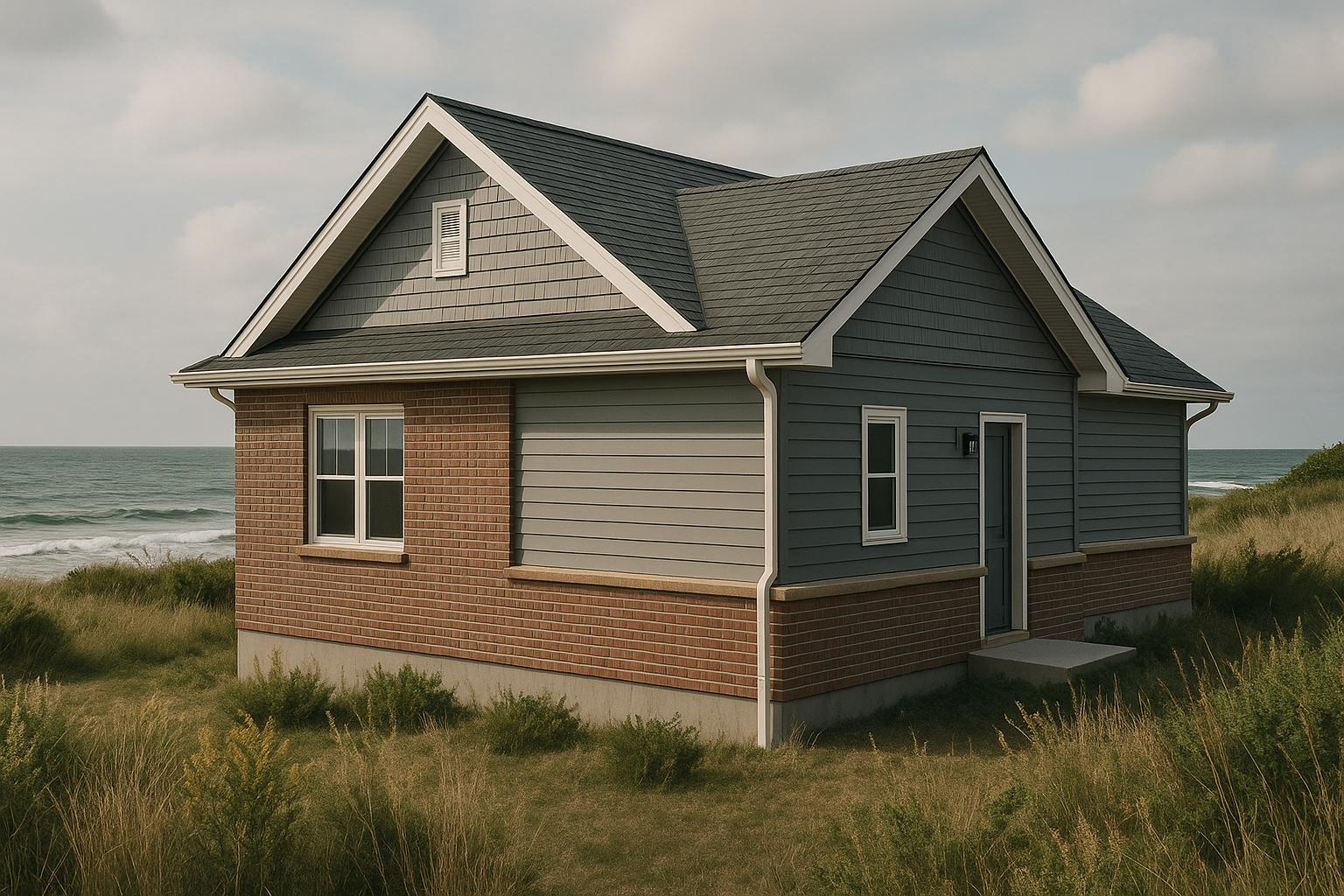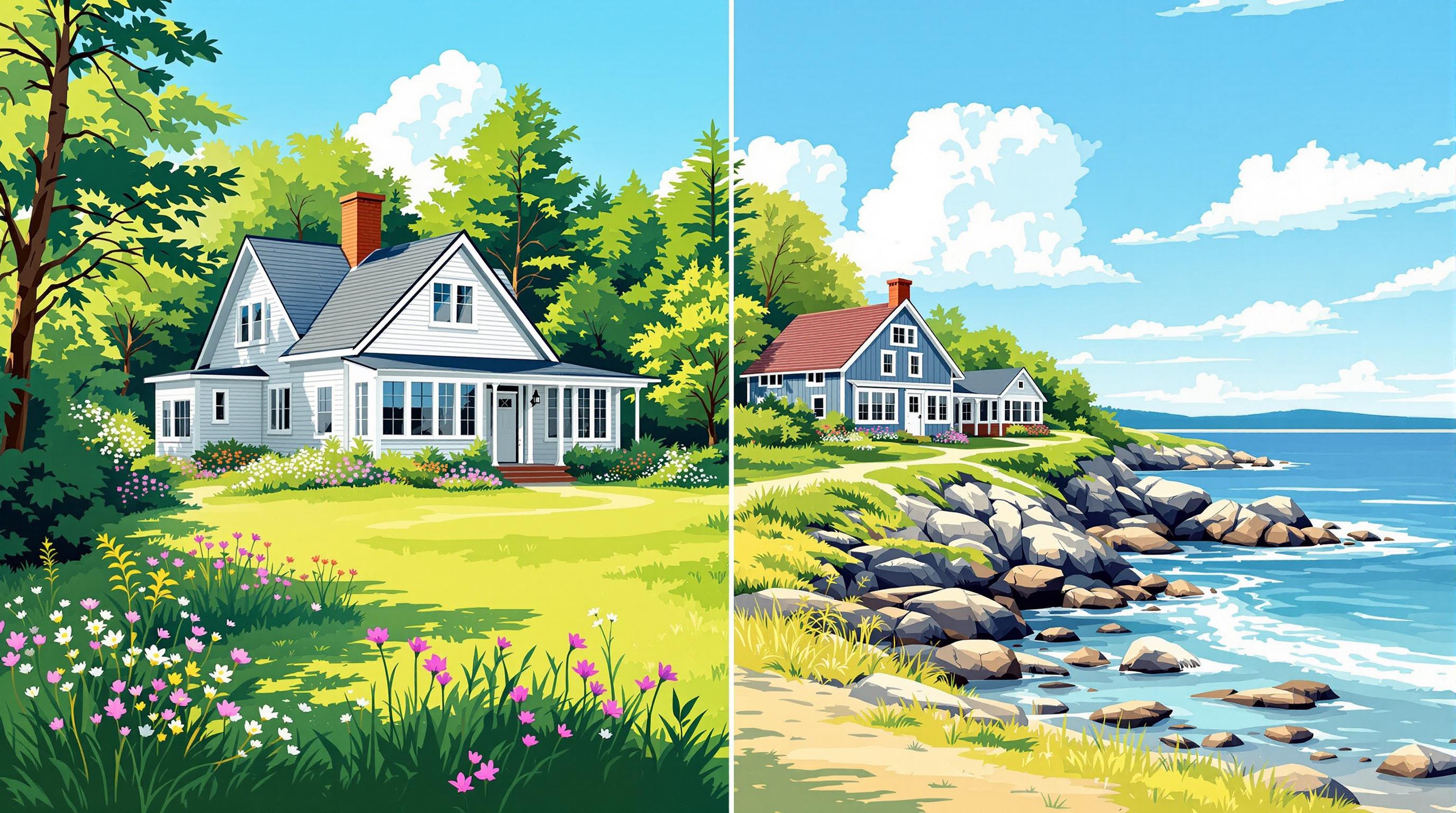Nova Scotia’s coastal climate is harsh on buildings. Salt air, high humidity, and extreme weather can corrode materials, cause moisture damage, and shorten the lifespan of structures. Choosing the right materials is critical for reducing maintenance costs and protecting your investment in multi-unit properties. Here's a quick summary of the best materials for these conditions:
- Fibre Cement Siding: Moisture-resistant and durable against temperature changes, unlike vinyl or wood.
- Pressure-Treated Lumber: Resists rot and decay, ideal for framing and outdoor structures.
- Metal Roofing: Aluminium, galvanized, or coated steel withstand salt air and high winds.
- Marine-Grade Stainless Steel: Long-lasting fasteners and hardware resistant to salt corrosion.
- Composite Decking: Low-maintenance and resistant to UV and moisture damage.
- Triple-Glazed Windows & Impact-Resistant Doors: Improve insulation, withstand storms, and reduce energy costs.
- Salt-Resistant Concrete: Prevents cracking and corrosion in foundations, essential for flood-prone areas.
Proper installation and a well-designed building envelope are just as important as material selection. Skimping on quality can lead to costly repairs, while investing in durable materials ensures long-term value and lower upkeep. For Nova Scotia’s coastal climate, it’s all about materials that can handle salt, moisture, and storms while keeping your property protected.
Surviving Coastal Climates - Cladding, Decks, and More!
Coastal Climate Challenges for Construction
Nova Scotia's coastal environment presents unique challenges that can wear down construction materials at an accelerated pace. Recognizing these issues is essential for property owners to choose the right materials and plan for effective long-term maintenance.
Salt Air Corrosion Damage
Salt-filled air from the Atlantic Ocean is one of the harshest elements coastal buildings face. Salt particles settle on metal surfaces, speeding up corrosion. For instance, galvanized steel fasteners may corrode sooner than expected in these conditions, and aluminium siding without proper protective coatings can develop pitting and deposits that weaken its structure. Hidden components like fasteners in wall assemblies, HVAC systems, and electrical connections are equally at risk, often leading to expensive repairs. The closer a property is to the coast, the more severe the exposure, though even areas farther inland can experience these effects during storms.
High Humidity and Moisture Problems
Coastal regions like Nova Scotia are known for consistently high humidity levels throughout the year. This persistent moisture creates ideal conditions for wood rot and mould, which can compromise both the structure and indoor air quality. Wood absorbs moisture, leading to warping and decay, while engineered sheathing can delaminate if exposed to continuous dampness, especially when the building envelope isn’t adequately sealed.
Temperature fluctuations add to the problem by causing condensation within walls, which can lead to hidden damage over time. Poor ventilation encourages mould growth, resulting in costly remediation and repairs. Persistent moisture also takes a toll on paint and coatings, causing blistering, peeling, or chalking, which leaves the underlying materials vulnerable to further deterioration.
Storm Damage and Freeze-Thaw Cycles
Atlantic storms bring a mix of high winds, heavy rain, and sharp temperature changes that test the durability of building materials. High winds can lift roofing materials and put lateral pressure on siding, potentially causing failures if the materials aren’t rated for coastal conditions. Driving rain can seep into even the smallest gaps in a building’s envelope, damaging insulation, drywall, and structural framing while also leaving behind moisture that leads to long-term issues.
Freeze-thaw cycles compound the damage. Water that seeps into cracks expands when frozen, widening the gaps and accelerating material breakdown. Concrete, masonry, and roofing materials are particularly vulnerable, often showing signs of spalling, cracking, or reduced lifespan as a result.
Traditional construction methods designed for inland areas often fall short in Nova Scotia’s coastal climate. Addressing these challenges requires selecting materials specifically designed to withstand salt air, humidity, and severe weather conditions, ensuring durability and long-term value for coastal properties.
Best Materials for Coastal Multi-Unit Properties
Choosing the right materials for coastal multi-unit properties is about finding options that can handle harsh conditions, offer durability, and require minimal upkeep. Below, we’ll explore materials designed to meet these specific challenges.
Fibre Cement Siding
Fibre cement siding is a standout choice for exterior cladding in coastal areas. Made from a mix of cement, sand, and cellulose fibres, it’s built to resist moisture, fire, and wear over time.
Unlike vinyl, which can crack in colder temperatures, or wood, which demands regular maintenance, fibre cement holds up well against temperature fluctuations. It won’t warp, rot, or attract pests - qualities that are especially important for multi-unit buildings where maintenance can quickly become overwhelming.
For coastal settings, it’s crucial to choose fibre cement products rated for salt air exposure. Adding protective coatings or sealers can further enhance its resistance to corrosion and moisture.
Pressure-Treated Lumber and Engineered Wood
Wood components in coastal environments need extra protection to handle high moisture levels. Pressure-treated lumber is infused with chemical preservatives, making it resistant to rot, decay, and insect damage. This makes it a great option for structural framing, decks, and balconies.
When selecting wood, look for high-exposure rated pressure-treated lumber to ensure it can withstand the elements. Engineered wood products, like laminated veneer lumber (LVL) and glue-laminated timber, are also excellent choices. They offer greater strength and consistency compared to regular wood, reducing the risk of warping or splitting.
Proper installation plays a significant role here. Sealing all cut ends and using fasteners designed for treated wood is essential to prevent corrosion and extend the lifespan of the materials.
Metal Roofing: Aluminum, Galvanized, and Coated Steel
Metal roofing is an excellent solution for dealing with the tough weather conditions common in coastal areas. It provides outstanding resistance to wind and moisture, with different metals offering unique advantages.
Aluminum naturally forms a protective oxide layer, while galvanized and coated steel combine durability with cost-effectiveness. Coated steel, often treated with advanced polymer coatings, is particularly popular for its balance of performance and affordability. Standing seam designs are a smart choice for coastal roofs, as they reduce exposed fasteners (which can corrode) and offer superior protection against wind and water.
Marine-Grade Stainless Steel and Fasteners
Fasteners and hardware are the unsung heroes of durable coastal construction. Marine-grade stainless steel is especially well-suited to these environments. Type 316 stainless steel, in particular, offers excellent resistance to chloride, a common issue in salty air.
While hot-dip galvanized fasteners with additional coatings can work in many structural applications, marine-grade stainless steel is ideal for exposed hardware like railings, door handles, and window components. It reduces the need for frequent replacements. Additionally, avoiding galvanic corrosion - caused by incompatible metals - during installation is crucial to maintaining the integrity of the hardware.
Composite and Vinyl Products for Decking and Trim
Composite decking, made from recycled wood fibres and plastic resins, is a durable option for coastal properties. It resists moisture, UV rays, and salt exposure, making it a low-maintenance alternative to traditional wood decking, even if it comes with a higher initial cost.
For trim work, cellular PVC products are an excellent choice. They resist rot, splitting, and insect damage while offering the flexibility to be painted for custom colours. High-quality vinyl products are also a great fit for soffits, fascia, and window trim, as they hold up well against UV exposure and maintain their appearance over time.
sbb-itb-16b8a48
Building Envelope Protection
When it comes to safeguarding your property in Nova Scotia's coastal environment, the building envelope plays a crucial role. It serves as the first line of defence against moisture, energy loss, and structural damage - issues that can lead to expensive repairs if not addressed. A well-designed envelope ensures your investment is protected from the region's harsh elements.
Triple-Glazed, Storm-Resistant Windows
Windows are often the most vulnerable part of any coastal building. Choosing the right type can significantly improve both durability and energy efficiency. Triple-glazed windows offer better insulation than standard double-pane options, creating a thermal barrier that helps cut heating costs during Nova Scotia's cold winters.
For multi-unit properties near the coast, storm-resistant windows provide year-round protection without the hassle of seasonal adjustments. These windows typically feature reinforced frames made from materials like aluminium, vinyl, or steel composites. They also use laminated glass with PVB or SGP interlayers, making them tough enough to withstand severe weather conditions.
Energy-saving features like Low-E coatings and argon gas fills further enhance thermal performance, helping to lower heating and cooling expenses. Plus, the multi-layered construction reduces noise from strong winds, rain, and other external sounds. To complement these windows, impact-resistant doors add another layer of security to the building envelope.
Insulated, Impact-Resistant Doors
Doors in coastal areas face unique challenges, including exposure to salt spray, high winds, and fluctuating temperatures. Impact-resistant doors are designed to handle these conditions while keeping the building envelope intact.
These doors are tested to endure hurricane-force winds of up to 225 kilometres per hour and can withstand conditions equivalent to a Category 5 hurricane [2][5]. This level of protection prevents dangerous internal pressurization, which could otherwise lead to roof damage, wall collapses, or structural failure [4][5].
Constructed with reinforced frames, thermal breaks, and weather-tight compression seals, these doors minimize heat transfer and prevent air leaks [2][3][5]. Some models, like those made with Fibrex® composite, are especially effective - blocking thermal transfer nearly 700 times better than aluminium [1]. Additionally, they resist corrosion caused by salt spray and sea air, ensuring durability with minimal upkeep [1][2].
Continuous Insulation and Moisture Barriers
The overall resilience of a building envelope depends on more than just its windows and doors. Insulation and moisture management systems are equally important. Traditional insulation methods often leave gaps and thermal bridges that reduce performance, especially in coastal settings. Continuous insulation systems solve this problem by creating an uninterrupted thermal barrier around the entire building.
This approach is particularly beneficial for multi-unit properties, as it helps prevent condensation - a major cause of mould growth, which can affect tenant health and lead to liability issues. When paired with properly installed moisture barriers, continuous insulation systems effectively manage vapour movement and prevent moisture buildup. These systems combine vapour and air barriers with drainage planes to keep the building dry and structurally sound.
With building codes constantly evolving to address extreme weather conditions [4], investing in high-quality envelope protection not only lowers maintenance costs but also improves tenant satisfaction and boosts the long-term value of your property.
Foundations and Flood Protection
To keep your property standing strong, especially in coastal areas, it’s crucial to combine smart foundation design with effective flood protection. This approach not only ensures durability but also helps avoid expensive repairs down the road.
Elevated Foundations and Piers
In flood-prone areas, elevated foundations are a must. By raising the structure above expected flood levels, these designs let water flow underneath, reducing the risk of damage to the building’s structure.
Pier and beam foundations are particularly effective in these situations. Concrete or steel piers anchored in stable soil provide sturdy support while allowing floodwaters to pass beneath. This setup relieves hydrostatic pressure on foundation walls during storms, minimizing potential damage.
The elevation height should be guided by local flood risk assessments and historical storm data. Builders should consult local authorities and follow regional guidelines to determine how high a structure needs to be raised. Incorporating breakaway walls is another smart move - they allow water to pass through, reducing lateral pressure. For multi-unit properties, open foundation designs with minimal enclosures beneath the raised structure can also prevent water from pooling, avoiding issues like uplift forces or moisture damage.
Salt-Resistant Concrete and Waterproofing
Saltwater can be brutal on concrete, so using the right materials is essential. Marine-grade concrete mixes, enhanced with additives and lower water-cement ratios, are designed to resist salt penetration. Supplementary materials like fly ash, silica fume, or ground granulated blast furnace slag can further strengthen the concrete by filling in tiny pores, creating a dense barrier against chloride intrusion.
To prevent rust and cracking, opt for corrosion-resistant reinforcements such as epoxy-coated, stainless steel, or fibre-reinforced polymer rebar. While these materials might cost more upfront, they can save significant money by reducing the need for major repairs later.
For extra protection, crystalline waterproofing admixtures can make concrete self-sealing, blocking moisture even in small cracks. Waterproofing membranes provide a continuous seal for foundation walls, while bentonite clay panels below grade swell to form an impermeable barrier. Adding drainage systems like French drains and sump pumps ensures that groundwater and surface runoff are effectively diverted.
Conclusion: Building for Long-Term Value
Selecting the right materials for Nova Scotia's coastal environment is key to maximizing your long-term return on investment. By opting for high-quality materials, you can significantly cut down on future maintenance costs.
When premium materials are paired with a well-coordinated construction process, projects run more smoothly from start to finish. Skimping on material quality, on the other hand, can lead to budget overruns of 30–60%, often due to premature replacements. Issues like salt-corroded fasteners, moisture-damaged wood, or storm-worn siding can quickly turn a promising rental property into a financial burden.
Achieving success requires a unified approach where all components work seamlessly together. Take this scenario: an architect specifies triple-glazed, storm-resistant windows, but subpar fasteners are used during installation. The result? The benefits of those high-quality windows are severely undercut. This kind of fragmented planning is often why construction timelines stretch from the planned 8 months to 18 months - or even longer.
Disjointed contracting drives up costs and causes delays, but an integrated construction model can solve these issues. For example, Helio Urban Development brings planners, architects, engineers, and construction teams together under one roof. With 31 units currently under construction across Nova Scotia and 131 more in the pipeline, their fixed-price model delivers units at $160,000 each in just 6 months - guaranteed. This streamlined approach saves property owners around $47,000 in coordination costs on multi-unit projects.
The durable materials discussed in this guide - like salt-resistant concrete for elevated foundations, composite decking, and metal roofing - achieve optimal performance when installed as part of a complete system. Coastal rental properties need materials that can endure harsh winters, constant salt spray, and other environmental challenges, all while maintaining a strong annual ROI of 12–20%.
FAQs
Why is fibre cement siding a better choice than wood or vinyl for properties in Nova Scotia's coastal climate?
Fibre cement siding is a smart option for Nova Scotia’s coastal climate, where salt air, high humidity, and freezing winters can take a toll on building materials. This siding stands out for its durability. Unlike wood, it won’t rot, warp, or attract pests, and it offers much better fire resistance. When compared to vinyl, fibre cement is tougher, more resistant to strong winds, and less prone to fading, even in harsh weather.
For property owners, this means less upkeep, longer-lasting protection, and a siding option that can handle the challenges of the coast. It’s a practical choice, especially for multi-unit rentals, offering long-term savings and peace of mind.
What are the best ways to protect metal roofing from salt air and harsh weather in Nova Scotia's coastal climate?
To make sure your metal roofing holds up against Nova Scotia's salty air and harsh weather, go for corrosion-resistant materials like aluminum with PVDF coatings or long-lasting metals such as copper or zinc. Choosing panels with an aluminum core adds an extra layer of defence against rust and salt damage. Regular upkeep, like cleaning off salt deposits, is also key to maintaining the roof's durability and performance in a coastal setting.
What should I consider when designing a building envelope to handle Nova Scotia's tough coastal conditions?
To safeguard your building from Nova Scotia's challenging coastal conditions, it's essential to choose materials that can handle the elements. Options like fibre cement siding, stone, metal roofing, and stainless steel are excellent because they resist corrosion and hold up well against salt air, high humidity, and the rigours of harsh winters.
It's also smart to include moisture management solutions. Features such as vapour-permeable barriers, effective drainage systems, and elevated foundations help prevent water damage and allow walls to dry out properly. Pair these with impact-resistant windows and other weather-proofing upgrades to protect against strong winds and storms while staying compliant with local building regulations. By focusing on these factors, you’ll create a structure that’s built to last with minimal upkeep - perfect for the demands of coastal living.
Related Blog Posts
- Nova Scotia Building Code: Material Durability Standards
- Building on the Nova Scotia Coast: How to Design and Construct Durable Seaside Home
- Green Building in Nova Scotia: Top 10 Energy-Efficient Features for Your Custom Home
- Building Resilient Coastal Homes in Nova Scotia: Storm-Proof and Future-Ready



